Histology - Tissue Identification Flashcards
Identify:


Identify:


Identify:


Identify:


Identify:


Identify:


Identify:

Trasitional Epithelium / Urothelium
Identify:

Dense Bone
Identify:

Cancellous Bone
Identify:

Adipose Tissue
Identify:
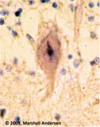
Purkinje Cell
Identify:


Identify:

Simple Cuboidal (Kidney)

Identify:


Identify:

Pseudostratified Columnar Epithelium

Identify:

Transitional Epithelium

Identify:

Mammary Gland (inactive)
- 1st pic shows cross section of duct.
- 2nd pic shows ducts and connective tissue.
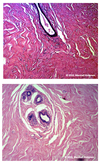
Identify:

Hyaline Cartilage
Identify:

Skeletal Muscle
Identify:


Identify:

Cardiac Muscle
Identify:


Identify:

Smooth Muscle
Identify:


Identify:

Cerebral Cortex - Pyramidal Cells
Identify:


Identify:

Stratified squamous epithelium - non-keratinized.
- See the presence of the nucleus in squamous cells.
Identify:


Identify:

Stratified squamous eithelium - Keratinized
- See lack of nucleus in squamous cells and flaking of cells at surface.
Identify:


Identify:

Simple cuboidal epithelium.
- Photomicrograph of kidney tubules
Identify:


Identify:

Stratified squamous - non keratinized
Identify:


Identify:

Simple cuboidal epithelium
Identify:

Submandibular Gland
- Both serous and mucous cells.
- Serous cells form serous demilune capping mucous acini.
- Myoepithelial cells surround acini.

Identify:

Simple columnar
Identify:

Submandibular Gland
- Both serous and mucous cells.
- Serous cells form serous demilune capping mucous acini.
- Myoepithelial cells surround acini.

Identify:

Transitional epithelium / Urothelium
Identify:

Submandibular Gland
- Both serous and mucous cells.
- Serous cells form serous demilune capping mucous acini.
- Myoepithelial cells surround acini.

Identify:

Simple columnar
Identify:

Sublingual Gland
- Mucous acini (pale in appearance)(PAS+)
- Flattened nuclei at basal poles of cells.
- Myoepithelial cells surround acini.
Identify:

Pseudostratified epithelium
Identify:

Submandibular Gland
- Both serous and mucous cells.
- Serous cells form serous demilune capping mucous acini.
- Myoepithelial cells surround acini.

Identify:


Identify:

Simple cuboidal
Identify:

Parotid Gland
- Serous acini
- Apical regions contain zymogen granules.
- RER predominates in basal regions of secretory cells.

Identify:


Identify:

Transitional epithelium / Urothelium
Identify:

Parotid Gland
- Serous acini
- Apical regions contain zymogen granules.
- RER predominates in basal regions of secretory cells.
Identify:


Identify:

Simple cuboidal
- Thyroid tissue showing thyroxine globules.
Identify:

Parotid Gland
- Serous acini
- Apical regions contain zymogen granules.
- RER predominates in basal regions of secretory cells.
Identify:


Identify:

Simple columnar
Identify:

Submandibular Gland
- Both serous and mucous cells.
- Serous cells form serous demilune capping mucous acini.
- Myoepithelial cells surround acini.
Identify:

Review lecture 11/13/18 for description.

Identify:

Sublingual Gland
- Mucous acini (pale in appearance)(PAS+)
- Flattened nuclei at basal poles of cells.
- Myoepithelial cells surround acini.
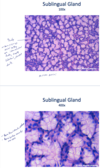
Identify:

Submandibular Gland
- Both serous and mucous cells.
- Serous cells form serous demilune capping mucous acini.
- Myoepithelial cells surround acini.

Identify:

Sickle Cell Erythrocytes
Identify:

Parotid Gland
- Serous acini
- Apical regions contain zymogen granules.
- RER predominates in basal regions of secretory cells.

Identify:

Submandibular Gland
- Both serous and mucous cells.
- Serous cells form serous demilune capping mucous acini.
- Myoepithelial cells surround acini.

Identify:

Neutrophils 1000x
Identify:

Submandibular Gland
- Both serous and mucous cells.
- Serous cells form serous demilune capping mucous acini.
- Myoepithelial cells surround acini.

Identify:

Submandibular Gland
- Both serous and mucous cells.
- Serous cells form serous demilune capping mucous acini.
- Myoepithelial cells surround acini.

Identify:
Eosinophil

Identify:
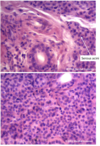
Parotid Gland
- Serous acini
- Apical regions contain zymogen granules.
- RER predominates in basal regions of secretory cells.

Identify:

Submandibular Gland
- Both serous and mucous cells.
- Serous cells form serous demilune capping mucous acini.
- Myoepithelial cells surround acini.
Identify:

Basophil
Identify:

Sublingual Gland
- Mucous acini (pale in appearance)(PAS+)
- Flattened nuclei at basal poles of cells.
- Myoepithelial cells surround acini.
Identify:


Identify:

Lymphocyte 1000x
Identify:

Sublingual Gland
- Mucous acini (pale in appearance)(PAS+)
- Flattened nuclei at basal poles of cells.
- Myoepithelial cells surround acini.
Identify:


Identify:

Monocyte 1000x
Identify:

Sublingual Gland
- Mucous acini (pale in appearance)(PAS+)
- Flattened nuclei at basal poles of cells.
- Myoepithelial cells surround acini.

Identify:

Hyaline Cartilage
Identify:

Promegakaryocyte
Identify:

Sublingual Gland
- Mucous acini (pale in appearance)(PAS+)
- Flattened nuclei at basal poles of cells.
- Myoepithelial cells surround acini.

Identify:

Elastic Cartilage
Identify:

Promegakaryocyte
Identify:

Sublingual Gland
- Mucous acini (pale in appearance)(PAS+)
- Flattened nuclei at basal poles of cells.
- Myoepithelial cells surround acini.
Identify:

Fibrous Cartilage
Identify:

Proerythroblast
Identify:

Submandibular Gland
- Both serous and mucous cells.
- Serous cells form serous demilune capping mucous acini.
- Myoepithelial cells surround acini.

Identify:


Identify:

Proerythroblast
Identify:

Submandibular Gland
- Both serous and mucous cells.
- Serous cells form serous demilune capping mucous acini.
- Myoepithelial cells surround acini.

Identify:


Identify:

Reticulocytes
Identify:


Identify:


Identify:

Skeletal Muscle
Identify:


Identify:

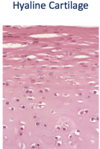
Identify:

Skeletal Muscle
Identify:


Identify:


Identify:

Skeletal Muscle
Identify:


Identify:


Identify:

Skeletal Muscle
Identify:


Identify:

Developing membrane bone in fetus.
Identify:

Skeletal Muscle
Identify:


Identify:

NAD stain (oxidative phosphorylation) - Type I fibers stain darker than type II fibers.

Identify:


Identify:

Smooth Muscle
Identify:


Identify:

Cardiac Muscle
Identify:


Identify:

Cardiac Muscle - Acute MI
Identify:


Identify:

Satellite Cells

Identify:


Identify:

Muscle Spindles

Identify:


Identify:

Cardiac Muscle
Identify:


Identify:

Cardiac Muscle
Identify:


Identify:

Cardiac Muscle - AMI
Identify:


Identify:

Cardiac Muscle - Purkinje Fibers
Identify:


Identify:

Smooth Muscle
Identify:


Identify:

Smooth Muscle
Identify:


Identify:


Identify:


Identify:


Identify:

Normal RBCs
Identify:

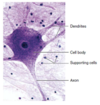
Identify:


Identify:


Identify:


Identify:


Identify:


Identify:

Astrocytes around capillary
Identify:

Astrocyte
Identify:


Identify:

Pseudounipolar Neuron in Dorsal Root Ganglion
Identify:


Identify:


Identify:


Identify:


Identify:


Identify:


Identify:


Identify:


Identify:


Identify:


Identify:


Identify:


Identify:


Identify:


Identify:


Identify:

Lymph Node

Identify:

Atherosclerosis of Aorta
- M = tunica media
- I = tunica intima with large atheromatous lesion.

Identify:


Identify:

Submandibular Gland
- Both serous and mucous cells.
- Serous cells form serous demilune capping mucous acini.
- Myoepithelial cells surround acini.

Identify:


Identify:

Sublingual Gland
- Mucous acini (pale in appearance)(PAS+)
- Flattened nuclei at basal poles of cells.
- Myoepithelial cells surround acini.
Identify:


Identify:

Submandibular Gland
- Both serous and mucous cells.
- Serous cells form serous demilune capping mucous acini.
- Myoepithelial cells surround acini.

Identify:


Identify:

Parotid Gland
- Serous acini
- Apical regions contain zymogen granules.
- RER predominates in basal regions of secretory cells.

Identify:


Identify:

Parotid Gland
- Serous acini
- Apical regions contain zymogen granules.
- RER predominates in basal regions of secretory cells.
Identify:


Identify:

Parotid Gland
- Serous acini
- Apical regions contain zymogen granules.
- RER predominates in basal regions of secretory cells.
Identify:


Identify:

Submandibular Gland
- Both serous and mucous cells.
- Serous cells form serous demilune capping mucous acini.
- Myoepithelial cells surround acini.
Identify:


Identify:

Submandibular Gland
- Both serous and mucous cells.
- Serous cells form serous demilune capping mucous acini.
- Myoepithelial cells surround acini.

Identify:


Identify:

Submandibular Gland
- Both serous and mucous cells.
- Serous cells form serous demilune capping mucous acini.
- Myoepithelial cells surround acini.

Identify:


Identify:

Submandibular Gland
- Both serous and mucous cells.
- Serous cells form serous demilune capping mucous acini.
- Myoepithelial cells surround acini.

Identify:


Identify:

Submandibular Gland
- Both serous and mucous cells.
- Serous cells form serous demilune capping mucous acini.
- Myoepithelial cells surround acini.
Identify:


Identify:

Sublingual Gland
- Mucous acini (pale in appearance)(PAS+)
- Flattened nuclei at basal poles of cells.
- Myoepithelial cells surround acini.

Identify:


Identify:

Parotid Gland
- Serous acini
- Apical regions contain zymogen granules.
- RER predominates in basal regions of secretory cells.

Identify:

Simple Cuboidal Epithelium
Identify:

Submandibular Gland
- Both serous and mucous cells.
- Serous cells form serous demilune capping mucous acini.
- Myoepithelial cells surround acini.

Identify:

Simple Cuboidal Epithelium
Identify:

Parotid Gland
- Serous acini
- Apical regions contain zymogen granules.
- RER predominates in basal regions of secretory cells.
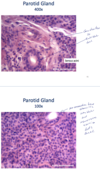
Identify:

Stratified Squamous Epithelium - Skin
Identify:

Sublingual Gland
- Mucous acini (pale in appearance)(PAS+)
- Flattened nuclei at basal poles of cells.
- Myoepithelial cells surround acini.
Identify:

Cerebral Cortez - Pyramidal Cells

Identify:

Sublingual Gland
- Mucous acini (pale in appearance)(PAS+)
- Flattened nuclei at basal poles of cells.
- Myoepithelial cells surround acini.
Identify:

Purkinje Cell in Cerebral Cortex
Identify:

Sublingual Gland
- Mucous acini (pale in appearance)(PAS+)
- Flattened nuclei at basal poles of cells.
- Myoepithelial cells surround acini.

Identify:

Eye Development in 72 Hr Chick Embryo

Identify:

Sublingual Gland
- Mucous acini (pale in appearance)(PAS+)
- Flattened nuclei at basal poles of cells.
- Myoepithelial cells surround acini.

Identify:


Identify:

Sublingual Gland
- Mucous acini (pale in appearance)(PAS+)
- Flattened nuclei at basal poles of cells.
- Myoepithelial cells surround acini.
Identify:

Anatomy of Eye

Identify:


Identify:

Tunics of Eye

Identify:


Identify:

Cornea

Identify:


Identify:


Identify:


Identify:


Identify:


Identify:


Identify:


Identify:


Identify:


Identify:


Identify:


Identify:


Identify:


Identify:


Identify:


Identify:


Identify:


Identify:


Identify:


Identify:


Identify:


Identify:


Identify:


Identify:


Identify:


Identify:


Identify:


Identify:




